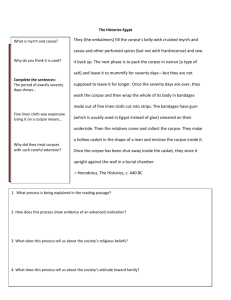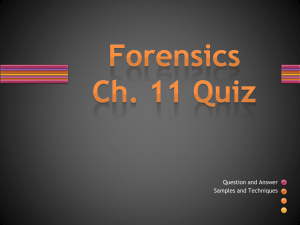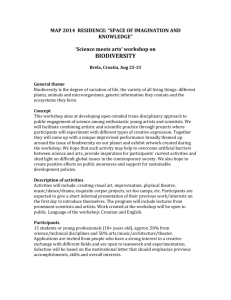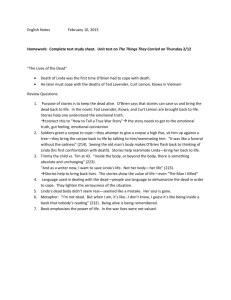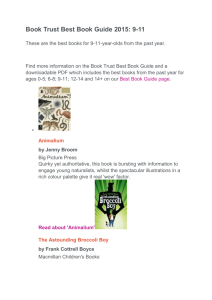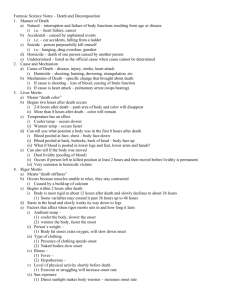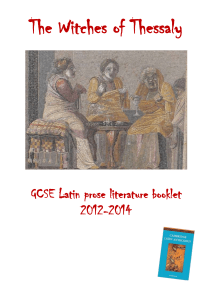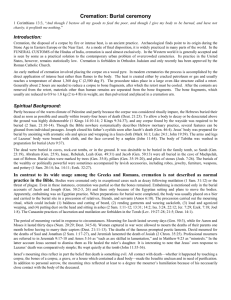Bezan Research Essay..
advertisement
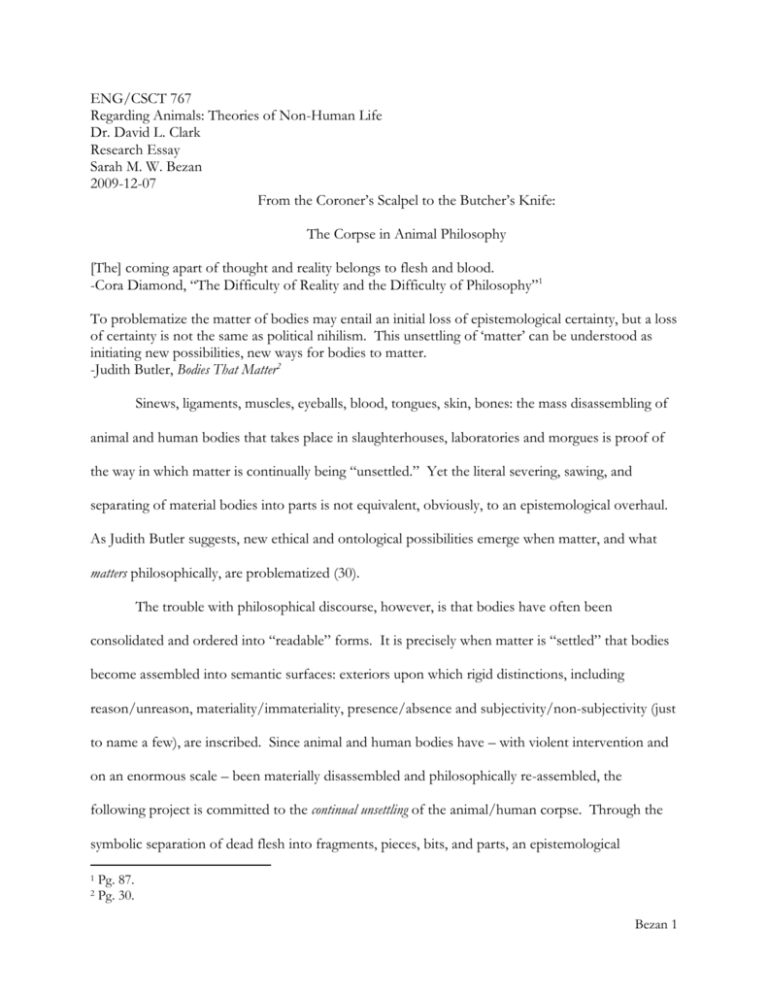
ENG/CSCT 767 Regarding Animals: Theories of Non-Human Life Dr. David L. Clark Research Essay Sarah M. W. Bezan 2009-12-07 From the Coroner’s Scalpel to the Butcher’s Knife: The Corpse in Animal Philosophy [The] coming apart of thought and reality belongs to flesh and blood. -Cora Diamond, “The Difficulty of Reality and the Difficulty of Philosophy”1 To problematize the matter of bodies may entail an initial loss of epistemological certainty, but a loss of certainty is not the same as political nihilism. This unsettling of ‘matter’ can be understood as initiating new possibilities, new ways for bodies to matter. -Judith Butler, Bodies That Matter2 Sinews, ligaments, muscles, eyeballs, blood, tongues, skin, bones: the mass disassembling of animal and human bodies that takes place in slaughterhouses, laboratories and morgues is proof of the way in which matter is continually being “unsettled.” Yet the literal severing, sawing, and separating of material bodies into parts is not equivalent, obviously, to an epistemological overhaul. As Judith Butler suggests, new ethical and ontological possibilities emerge when matter, and what matters philosophically, are problematized (30). The trouble with philosophical discourse, however, is that bodies have often been consolidated and ordered into “readable” forms. It is precisely when matter is “settled” that bodies become assembled into semantic surfaces: exteriors upon which rigid distinctions, including reason/unreason, materiality/immateriality, presence/absence and subjectivity/non-subjectivity (just to name a few), are inscribed. Since animal and human bodies have – with violent intervention and on an enormous scale – been materially disassembled and philosophically re-assembled, the following project is committed to the continual unsettling of the animal/human corpse. Through the symbolic separation of dead flesh into fragments, pieces, bits, and parts, an epistemological 1 2 Pg. 87. Pg. 30. Bezan 1 framework inclusive of the plurality of matter is established. Such a project is indebted to Jacques Derrida’s own rigorous work on the question of the animal, in which he explodes the “singular, indivisible line” that separates animal from human into a “multiple and heterogeneous border” (The Animal That Therefore I Am 31). To build a framework upon multiple corporeal fragments, therefore, is not to violently categorize, rationalize, or bring to order these pieces; rather, it is to emphasize their complex heterogeneity. Thus, taking the figure of the corpse as a site of rupture – as the space within which distinctions between humans and animals collapse – this thanatological framework of body parts draws from the long history of death and disease that form the basis of the animalhuman relationship, and reveals both human and animal death to be inimitably unstable concepts. What this philosophical project does not do, however, is attempt to conflate human and animal bodies as if the violence done to both were equivalent. For the slaughtering of animal bodies by far exceeds the numbers of dissected human cadavers – and furthermore, necessarily entails the copious killing (rather than the natural death) of animals. This thanatological approach is, therefore, jointly materialist and deconstructionist in that it critiques not only the vacuum-sealed packaging of meat for consumption, but also the anatomical dissection of bodies for the purposes of medical knowledge. These problems (divided in this essay into their respective sections: “Eating,” followed by “Gazing”) invite philosophical critique, since they depend upon unitary constructions of the material and symbolic realities of dead bodies. This critique will be similar to the way in which Nicole Shukin admirably tracks “animal and capital...in genealogical relation to one another [so that] they will break down as monolithic essences and reveal their historical contingencies” (15). To these problems, however, I will return in a moment. The history of death and disease that structures the human-animal relationship serves as the starting point for the task of philosophical disassembly, since the localizing, homogenizing discourses of medicine that so rigorously draw distinctions between animals and humans emerge as a Bezan 2 direct result of the attempt to prevent mortality due to illness. So for a moment, then, an exploration of the sick or diseased body will be briefly undertaken in relation to both veterinary practice and clinical medicine. Joanna Swabe argues in Animals, Disease, and Human Society: HumanAnimal Relations and the Rise of Veterinary Medicine that animal medicine largely provided “preventative” rather than “curative” treatment – meaning that care was “aimed at preserving animal resources, to keep animals fit and healthy in order that they may efficiently service human needs” (151, 154). However, Swabe erroneously argues that the domestication of animals since the inception of agrarian civilization was a “mutually beneficial” relationship, ensuring the survival of both humans and animals (36). Swabe does not comment on the fact that animal death was prevented by veterinary medicine only insofar as it remained profitable to humans, nor does she acknowledge the grim reality that livestock and other large domesticated animals are eventually butchered. Moreover, that veterinary medicine – especially since the industrialization of livestock productions in the eighteenth century – did not generally provide curative treatment, but instead isolated and killed sick animals (Swabe 92), suggests that sick animal bodies have throughout history been deemed threatening and rendered disposable. While Swabe argues that one of the most significant, though much overlooked, repercussions of animal domestication “was the advent of infectious disease on an epidemic scale...resulting in great mortality – amongst both animal and human populations” (44, my emphasis), the swift isolation and mass decimation of sick animal bodies as opposed to human bodies demonstrates the way in which rigid distinctions and ethical judgments were (and perhaps still are being) made in veterinary discourse. In medical discourse, the existence of illnesses shared by animals and humans, including measles, influenza, mad cow disease, smallpox, avian flu, and swine flu, are similarly localized: imagined, in fact, as distinct “entities” (Helman 123). Indeed, as Michel Foucault explains in Birth of the Clinic, diseases were even “grouped into orders, genera, and species” in the human body (42, italics Bezan 3 mine). As Foucault later explains, distinctions were made between the person and the disease, and the medical gaze effectively “read” the symptoms of the body from within and without. The body was “observed in terms of symptoms and signs...distinguished from one another as much as by their semantic value as by their morphology” (90). In other words, despite the separation of the sick body into parts (healthy person, unwelcome disease), the surface of the body was still “read” as though it were an uncontaminated whole. Despite the fact that the human-animal relationship is one indelibly marked by interspecies infection and shared sickness, scientific discourse rigorously and hygienically separates itself from that which is deemed to be non-human. Yet that animal and human tissue are already rendered indistinguishable through such infection makes sense of the current panic surrounding H1N1 inoculation and what Shukin suggests is “the medical rationalization of humananimal commingling that pandemic speculation universally mandates” (189). Derrida’s comments on auto-biography and auto-infection further complicate this point, since they suggest that inoculation threatens subject formation: “an immunizing movement...is always threatened with becoming auto-immunizing, as is every autos, every ipseity, every automatic, automobile, autonomous, auto-referential movement” (qtd. in Shukin 221). That the injection of “a ‘sick’ bit of an animal’s body into one’s own” results in a kind of self-attack illustrates the anxiety that surrounds interspecies identification as “distinct” and subjectivity as “self-same” (Shukin 221). While my intention is not to linger on the conceptual framework of sick bodies, it is important to note that the infections spread between animals and humans initiated, to some degree, the emergence of scientific discourses that attempted to localize and isolate animal bodies, and that these same distinctions were carried over to the corpse. Moreover, the gross fact that cross-species transmission of disease has historically resulted in mass human and animal death becomes staggering when added to the current decimation of animal livestock. It is from this traumatic past and disconcerting present that a study Bezan 4 of the corpse begins, and it is thus to the material and symbolic constructions of bodies that I now return. Like the parts of the sick body that are ordered and “read,” the corpse is similarly settled into a semantic surface. Yet what makes the corpse a site of dramatic rupture is that the kinds of distinctions placed upon it, namely reason/unreason, materiality/immateriality, presence/absence and subjectivity/non-subjectivity, are never entirely stable concepts. More intriguingly, the kinds of definitions that are circulated in medical discourse regarding the essence of the corpse (that it is a body of non-reason, materiality, absence, and non-subjectivity) have been assigned over and over again not only to dead, but more compellingly, to live animal bodies. The Cartesian animal, a soul-less, non-reasoning, biological automaton, does indeed bear a resemblance to current medical conceptions of the corpse. That both animal bodies (as with the dog, “Bobby,” in Levinas’s autobiographical work) and human bodies (as with the Jews, destroyed in the death camps) can be “animalized” as David Clark suggests (45), opens up another space in which, perhaps, living animal and human bodies are “corpsified.” Are corpses, in addition to living beings, “corpsified”? Indeed, what is a corpse? Institutional human sciences and the language of medical knowledge insist that the corpse is a site of truth, observation, and experimentation (Jones 166), but do so assuming that its essence is understood. As Foucault writes, With the coming of the Enlightenment, death, too, was entitled to the clear light of reason, and became for the philosophical mind an object and source of knowledge...[I]n the boldness of the gesture that violated only to reveal, to bring to the light of day, the corpse became the brightest moment in the figures of truth. Knowledge spins where once larva was formed. (125) Bezan 5 The image of larva in this excerpt is one of both festering worms feeding upon a decaying body, and of disembodied spirits (larvae) – indeed an intriguing conflation. For even in the “clear light of reason,” Foucault’s cadaver is problematically both immaterial and in a state of decay. Though static and vulnerable, the corpse is ultimately not in a latent state: even when embalmed or stored in formaldehyde, it cannot be taken for granted as a “fixed category” (Evans 1). Alternatively, to use a Butlerian turn of phrase, the matter of the corpse ought never to be wholly settled upon in philosophical language. As Katherine Young suggests in her work, Presence in the Flesh: The Body in Medicine, the aristocratization of medical language symbolically “purified, etherealized, and disembodied” the corpse (137) by suppressing “the grotesque, the material lower bodily stratum” (114). Like Foucault’s cadaver, what is intriguing about the “decorporealized etherealism” of the corpse in Young’s discussion of aristocratic discourse is that it concomitantly avows and disavows the materiality of death (Young 90). At once a negation and an allowance, the inconsistencies of medical discourse reveal the way in which matter cannot be altogether settled. Rather, the “material lower bodily stratum” is always contaminating the pure, aristocratized medical language. Drawing from Mikhail Bakhtin’s work on the carnivalesque, Young’s engagement with the grotesque body explores, among other things, the roasting and taking up of meat, or the ‘Carne levare’ of carnival (113). Intriguingly, this engagement with the ambiguity of flesh and the roasting of meat is situated pre-eighteenth-century, a time before the corpse was inexorably invented and fabricated by scientific language (Young 3). It is at this juncture of meat and the carnivalesque body that a more systematic “unsettling” of matter can take place. More specifically, it is in the space of the carnival that categories of dead animal and human bodies are disrupted. Eating: Cannibalism and the Carnivalesque Corpse Autopsy is threatened by the breaking through of grotesque realism, by the thought, the hint, the whiff of sausages. Bezan 6 -Katherine Young, Presence in Flesh: The Body in Medicine3 As the epigraph to this section suggests, the blurring of human and animal flesh as “meat” problematizes the boundary separating that which is edible and inedible, human and non-human. Within the context of the carnivalesque, the human and animal body are interminably entangled. In his discussion of tripe, for instance, Bakhtin notes that it is linked with death, with slaughter, murder, since to disembowel is to kill...it is linked with birth, for the belly generates. Thus, in the image of tripe, life and death, birth, excrement, and food are drawn together and tied in one grotesque knot..[it ] is the center of the bodily topography in which the upper and lower stratum interpenetrate each other. (qtd. in Young 112). In a grotesque mixture of self/other, human/animal, and life/death, eating meat is thus an establishment of subjectivity (but of course, a problematic one, as I will soon explain). As Cora Diamond profoundly states, “we learn what a human being is in – among other ways – sitting at a table where we eat them” (The Realistic Spirit 324). Similarly, in “Eating Well,” Derrida argues that subjectivity “dislocates or divides itself in gathering itself together to answer to the other, whose call somehow precedes its own identification with itself” (261). The boundary separating self from Other is one structured by an appetitive economy: the consumption of self-knowledge (or in another words, the consumption of another in order to establish oneself). What is significant, however, about the consumption of another is that it is, to draw upon the Kristevean logic of abjection, a kind of reverse-abjection. Since abjection and self-sedimentation come through an acknowledgment of, and separation from, another (3), eating flesh problematizes self-identification. While it may seem that to eat flesh is to be more full of life, as J.M Coetzee suggests in “On Appetite,” it seems that 3 Pg. 129. Bezan 7 one is actually to be more full of death (119). For the corpse, “the most sickening of wastes” is, as Julia Kristeva remarks, “a border that has encroached upon everything” (3). Furthermore, the human corpse is “waste, transitional matter, mixture, it is above all the opposite of the spiritual, of the symbolic, of the divine law” (Kristeva 109). But could not the same be said of the animal corpse? If so, why eat animal flesh? Kristeva suggests that eating animal meat is a “necessary evil” – an “acknowledgement of a bent toward murder essential to human beings” (96). Such an authorization to eat another, Kristeva goes on, “was the recognition of that ineradicable ‘death drive,’ seen here under its most primordial or archaic aspect – devouring” (96). The death drive, that thanatological impulse spinning from order to disorder; from life to death, is thus strangely counter-intuitive in its bend towards self-destruction. To eat another, then, is at once to settle and unsettle oneself. However, the question still remains: since we eat animals, why do we not eat human flesh? Is not my fellow human nevertheless an Other? Despite the disorder that the “devouring” aspect of the death drive leaves in its wake, Kristeva suggests that eating and subjectivity are structured around an ordered system of “established taxonomy” (98) – that is to say, a system of clean/unclean beings. More generally, it is a system of animals that do not eat one another (clean), and those that do (unclean). While I will return to the messy notion of eating bodies made up of the other bodies, I will for now suggest that the eating of unclean bodies is undesirable or (ritualistically) taboo in that it multiplies and aggregates the border of the self, thereby threatening it. With this in mind, do we not eat our fellow human beings for the same reason that we do not eat carnivorous animals? The act of dissection, for instance, is not much different from the rendering of the animal into items that fill the meat case, since it presumably depends upon the notion that the matter being exscinded is not connected to a present subject. Moreover, comparative anatomical studies have found that human and animal flesh are often indistinguishable from one another. The evolutionary studies undertaken Bezan 8 by Charles Darwin, for instance, suggest that “there is no sharp break between human beings and animals” (de Waal in Calarco 62). Similarly, in her work, “Chardin’s Fur: Painting, Materialism, and the Question of the Animal Soul,” Sarah Cohen writes: The question of what constituted the human soul, in the face of the physiological facts uncovered by anatomical studies, posed...a significant challenge to early modern understandings of souls as immaterial and immortal...[W]ith comparative anatomy revealing the human and quadruped bodies to be so alike, one had to wonder what, in fact, distinguished humanity at all (44). The relative indistinguishability of animal and human flesh scratches the surface of our discomfiture: for to have flesh like an animal is to be an animal. Or to agitate the (t)issue further, it is the suggestion that the human corpse bears traces of personhood, and that the animal corpse too is embedded with immateriality, presence, and subjectivity – and is thus demanding of integrity. For even the machinic, automated animal, according to Descartes, had a material soul: the esprit (animal spirit) was supposedly housed in the blood of the animal that circulated in the brain, nerves, and muscles (Cohen 44). With the possibility of the material existence of an animal spirit, would it not be conceivable that the human soul is also contained within flesh? Along the same hyperbolic vein, then, would the idea of animals feeding on other animals be just as perturbing? “‘[A]nimal cannibalism,’” also known as “the agroindustrial practice of feeding rendered remains of ruminants back to livestock” (Shukin 205), reveals the way in which body parts are consumed and materially re-distributed into other bodies. Since these dead animal body parts are literally recycled into living bodies (similar to the way that animal meat products consumed by humans are broken down and used by their bodies), it is significant to explore for a moment the semantic surface constructed upon the “eater” and the “eaten.” While the supposedly whole, replete Bezan 9 body that eats and digests body parts is at once multiplied and fragmented, the corporeal markers of the species divide are imbibed and absorbed, leaving no trace of a heterogeneous body on the surface. Eating meat, then, in effect collapses the species divide through ingestion and osmosis. While it is productive to consider a collapse of the species divide (since it aids in problematizing the supposedly stable distinctions placed upon animal and human flesh as radically separate), it is also worth noting that a maintenance of this border in relation to the consumption of flesh can, with as much rigor, unsettle the matter of the self. In the photographic work of Janieta Eyre, for instance, with its uncanny and discomforting representation of grotesque doubles and rotting carcasses, the human-animal boundary is fraught with the intermingling of selves and bodies. In Eyre’s “Pissing Silverfish” (1995) for example, the secretions of the body (already an abject substance) are poured into a glass jar, revealing the attempt of the subject to define or limit the bounds between self and other. Fig. 1. Janieta Eyre. Pissing Silverfish. Fibre-based selenium toned print. 1995. CristineRose Gallery. However, the secretions of the body are no longer liquefied – they are (or have been transformed into) small silverfish – or else they have remained whole since their ingestion. This nonsensical urination reveals the way in which, as Bakhtin argues, the carnivalesque, grotesque body is not Bezan 10 separate from the rest of the world, but is “‘blended with the world, with animals, with objects’” (Bakhtin qtd. in Russo 8, my emphasis). This work confounds the attempt to label or compartmentalize, since the presence of fish rather than “proper” bodily secretions is absurd to say the least. In a ludicrous and comedic gesture, the fully dressed self on the left disgustedly (or prudishly) turns up her nose, suggesting that the act of urination (in terms of establishing self from other) is, in and of itself, a farce. Moreover, defecation and excrement are revealed to be revolting in that the consumed fish enters and exits the body without being separated into parts. In a profound reversal, the expected settling of matter (the fish as organically liquefied excrement) is unsettled precisely in that it is “not-settled.” Fig. 2. Janieta Eyre. On the Imperfections of my Lover. Black and white print. 1995. Diane Farris Gallery. Conversely, in the photograph, “On the Imperfections of My Lover” (1995), Eyre separates the liquefied corpse into labelled jars; markers of self-containment. Yet, the composite nature of the liquid resists identification, for the body parts of the corpse are stewed together in a mélange of bits. Bezan 11 The twins, matched in headpieces and belted gowns, appear before a kitchen table covered with jars that read, “HAIR,” “TEETH,” “EYES,” “MOUTH,” “NOSE,” “NAILS,” etc. The varying amounts of darkish liquid in each jar have been poured from the teapot by the seated self. Precisely whose hair, teeth, eyes, etc., are contained within these jars is unclear: perhaps it is a composite of both the seated and the standing self, or an unidentified other. The liquefied body in this photograph is startling as it signals a solubility and fluidity of the self, as well as an austere compartmentalization of it. The look of dismay or disgust upon the face of the standing self suggests the repugnance of bodily secretions – and the subsequent attempt made by the seated self to categorize the liquid into labelled jars clearly reveals the way in which the corporeal body (and its secretions) are abject. For the secretions of the body are, as Julia Kristeva maintains, “opposed to I” (1); they both reinstate and destabilize the self as they occupy the boundary separating self from other (4). That such flesh-fluid is presented in the space of the kitchen as jarred food (one thinks of jam and jelly preserves), is certainly a Bakhtinian play with the carnivalesque body and the indistinguishability of animal and human flesh. It is similar to the gelatinous, amorphous mixture created when “animal stock [is] strained from the boilers of rendering plants” (Shukin 74). Eyre’s work unsettles subjectivity and bodies by rendering them, in one moment, into indeterminate matter, and refusing such rendering, at the next. Consuming the other, in Eyre’s “Pissing Silverfish,” is a surprising “non-settling” of matter: in refusing to collapse the species divide, it also negates the attempt made by the self to absorb, decompose, and subsequently expel animal tissue. In keeping the animal corpse (silverfish) intact, Eyre admirably unsettles our expectations of the material and symbolic reality of bodies – and with it, the animal-human divide. And in “On the Imperfections,” Eyre steeps and simmers the self into an indeterminate fluid, categorizing it in a move that is disturbingly cannibalistic. In refusing to sacrifice the animal, it is decidedly anti-carnophallogocentric. Eyre’s transgression of the animal/human and edible/inedible Bezan 12 boundary is similar to Young’s intimation that autopsy is threatened by the “whiff of sausages” (129). The illicit meat trade in the eighteenth-century, for instance, in which “knackers travelled to farms far and wide to collect cadavers with their dog carts, even digging up rotting carcasses to be brought back to the knackers’ yard to be processed into pies and sausages” (Swabe 114), evokes disgust not only because of the decaying, rotting meat that is being converted into food, but also because it elucidates the unsettling fact that human bodies are mortal, material and edible. Other examples, especially the tradition of anatomical drawings before the eighteenth-century, were “‘quite gruesome and even perverted, with unnecessary depictions of roped, twisted bodies’ and sometimes, ‘reminiscent of the appearance of meat on the block in a shambles’” (Tomlinson qtd. in Caldwell 332). The meat and deli aisle at the supermarket, to update this carnivalesque example, may well be, similarly, a semiotically-transitional space: a kind of morgue, a funeral parlour. Gazing: To (Dis)order and (Un)name I am getting lost again in the chasm that I see opening, for my part, wherever I, wherever the “I” crosses gazes – to the point of drowning there – with an animal that sees me seeing it seeing me naked. -Jacques Derrida, The Animal That Therefore I Am4 While an exploration of the carnivalesque corpse in relation to food and flesh does much to unsettle the boundaries of subjectivity/non-subjectivity, presence/absence, and material/immaterial, the nude, dissected, and anatomized body is a site of rupture that destabilizes notions of language (naming), order, and essence. First, however, an exploration of the history of dissection and publicly anatomized bodies ought to be undertaken. Before the inception of private dissections of the dead human body in the eighteenth-century, in which the body became objectified as a site of knowledge and inquiry, the carnivalesque tradition of public dissections “were sites of disruption, raucous outburst, and bawdy 4 Pg. 66. The Animal. Bezan 13 display” (Klestinec 434). These publically dissected bodies were carnivalesque, as Katherine Young argues, in that they were “split, severed, dismembered, eviscerated, turned inside out” (114). In addition to the public dissections, anatomical drawings during the Renaissance period often played with the boundary separating life and death: corpses assisting in their own dissections, walking around – even eating (Caldwell 330). As Janis McLarren Caldwell writes, “Subject or object, alive or dead, inside or outside, anatomized person or revivified corpse? The convention, until the late eighteenth-century, was always confoundedly both, refusing the dividing lines between what now seem to us as clear and coherent oppositions” (340). The animated cadavers in earlier anatomical drawings reveal the way in which the corpse was at once inside and outside, dead and alive. Fig. 3. Designer Unknown. Fronticepiece Portrait of Vesalius. Woodcut. 1543. Artstor. The presumably standing cadaver in this work from 1543 is partially dressed, and willingly offers his arm to the seated dissector. From his shoulder to his fingers, the tendons, bones, nerves and muscles become increasingly – and painfully, exposed. Such drawings unsettle matter with surprising absurdity and discomfort. Bezan 14 More intriguingly, the animal dissections slightly after this period, such as the 1671 and 1676 editions of the Parisian compilation of drawings, Mémoires pour servir à l’histoire naturelle des animaux, represented animals in conflicting states of life and death. As Anita Guerrini explains in “The ‘Virtual Menagerie’: The Histoire des Animaux Project,” the drawings of dissected animals included a taxonomic-anatomic drawing superimposed on top of a presumably “live” animal in its “natural” setting (35). Startlingly, these superimposed drawings of spirited and deceased animals disorient – perhaps more effectively than earlier drawings of lively human cadavers – the line between life and death, animal and human. On the one hand, these drawings provide evidence of the way that medical discourse has assigned non-reason, materiality, absence and non-subjectivity to the human corpse as well as to live animal bodies: for unlike most drawings of animated cadavers, the dead, dissected animal in the Histoire des Animaux compilation was separated from the live animal by separate pages, as if they were separate notions. Yet on the other hand, these images were nevertheless superimposed upon one another, demonstrating that live and dead animal bodies are not clearly separable. To animate a dead animal body, as well as a human corpse, is thus to open up new questions: as Anita Guerrini asks, “Could animals convey the same consciousness of mortality, including consciouness of the state of one’s soul, as could a human cadaver?” (37). If we return to the notion that the Cartesian animal as one entirely composed of machinic parts, with esprit contained within its flesh, then what does it mean to represent the lifeless animal corpse as conscious and vital? For to suggest the animation of a dead animal corpse is to intimate that its immaterial being is separate from its material existence, and exists apart from itself. To put it another way, it is to suggest that the animal has a soul. Bringing together materiality and immateriality, presence and absence, human and animal, public dissections and early modern anatomical drawings posit the corpse as a site of disruption: in effect, an “unreadable” semantic surface; a taxonomic body in riotous disorder. Bezan 15 More recently, the representation of dead animal and human bodies in art and sculpture – from Damien Hirst’s formaldehyde-encased sharks, cows, and sheep, to the plasticized human cadavers in Gunther von Hagen’s Body Worlds exhibitions – similarly intermingle life and death in fascinating ways. Yet unlike anatomical drawings, Hirst’s corporeal sculptures use and manipulate Fig 4. Damien Hirst. Away From the Flock. Mixed media sculpture. 1994. Tate Modern. real animal corpses in an attempt to preserve life: to be sure, his sheep and cattle very much bear the resemblance of livestock. While fascinating, Hirst’s sculptures do little to unsettle matter in new ways; if anything, they merely hold death in abeyance and refuse to allow its intermixture with life. And although some of Gunther von Hagen’s cadaverous art sculptures represent dead human bodies in the semblance of life (shooting basketballs, gymnastically contorting themselves, posing and performing), a number of these sculptures do little more than replicate the powerful medical gaze that orders and separates the body into nameable, technical parts – as the history of private dissections reveals. The private dissection/autopsy, a practice that slowly emerged during the late eighteenth century, was interested, as Foucault maintains, in dividing and categorizing the body while at the same time, binding it together (129). Foucault goes on to argue that the autopsy was first interested in the classification, followed by the geography, of organs: it was “ordinal” and then it was “localizing” (130). As Caldwell affirms, the rise of medical science corresponded with a new non-animated Bezan 16 cadaver, “quite thoroughly dead and in pieces” (343). For instance, the famous set of anatomical dissections, Gray’s Anatomy (still used widely today), represents the trend of displaying the human body as “shorn of emotion, imagination, agency, individuality, and personhood” (Caldwell 343). Moreover, the growing propensity among medical doctors to employ micro-anatomical tests, including “x-rays, plates, scans, [and] printouts of blood test results,” rather than gross anatomical analysis, even further denied the human corpse any association to immateriality or the presence of subjectivity (Helman 41). The micro-medical gaze that wields itself as the “point of concentration and the centre of diffusion” (Foucault 31) is joined at the proverbial hip to the anthropological project that attempts to name, gaze upon, and order human and animal bodies. Heidegger’s Daseincentric examination of the essence of humanity in Being and Time insisted, as Matthew Calarco relates, that “human beings and animals can be clearly and cleanly distinguished in their essence” (30). However, as Giorgio Agamben notes in his anti-anthropological work, The Open: Man and Animal, the taxonomic and evolutionary history of naming and ordering by Linnaeus relied on an imperative assumption of Homo Sapiens that was really “neither a clearly defined species nor a substance; it [was], rather, a machine or device for producing the recognition of the human” (26). Furthermore, Paola Cavalieri argues that the naming of humans has relied upon taking the animal as “a negative term of comparison” and a “normative rather than a descriptive concept” (3, 4). To unsettle everything from the Edenic scene of naming to the current medical tradition of taxonomic ordering, Derrida turns the gaze around. In his discussion of nudity and the gaze, Derrida destabilizes the anthropocentric gaze that has philosophically, scientifically, and anthropologically named and ordered animals. While Derrida explores the shame and selfdisidentificiation that comes when “an animal...sees me seeing it seeing me naked” (66), I want to further complicate the matter by examining the possibilities – or to be more exact – the impossibilities that are the result of looking upon, and being looked back by, an animal or human corpse. This Bezan 17 approach to thanatological specularity lies in direct opposition to other various intellectual economies of spectrality in relation to animals, such as that employed by Jonathan Burt – who argues that “the permutations of language and death form...around the figure of the animal” (158). Additionally, it is opposed to the argument of Akira Lippit in Electric Animal, in which he states that animals do not properly die, and “never entirely vanish” (1). To re-state my approach, I am interested in the material and symbolic realities of animals, and so I question, in the manner of Nicole Shukin, the critical approach of hauntology (the animal as a token of the death of language) as a way of “purportedly unsettl[ing] the ontological premises and power structures of Western culture” (29). With that said, I do admire Derrida’s own powerful arguments on language and death, as well as his insistence that we do not have a concept for the human or animal (in Wolfe, “Humanist” 57; Wolfe, “Flesh” 25). In a certain way, it is still from the Derridean framework of (un)language and speechlessness that gazing upon a corpse depends. Conclusion: Sympathetic Imagination and Embodied Living To gaze at (and to be gazed upon by) an animal or human corpse recognizes the impossibility of naming and ordering death. It is to return to Derrida’s “multiple and heterogeneous border”: [T]here is already a heterogeneous multiplicity of the living, or more precisely (to say ‘the living’ is already to say too much or not enough), a multiplicity of organizations of relations between living and dead, relations of organization or lack of organization among realms that are more and more difficult to dissociate by means of the figures of the organic and inorganic, of life and/or death. These relations are at once intertwined and abyssal, and they can never be totally objectified. (31). Derrida’s suggestion that death and life (in addition to animals and humans), coagulate at the border that separates them demonstrates that animals ought not to be positioned against humans in a state Bezan 18 of ultimate alterity. Rather, as Wolfe, Diamond, and others suggest, death itself is the ultimate other – meaning that “our shared embodiment, mortality, and finitude makes us...‘fellow creatures’” (Wolfe, “Flesh” 7). To toy with Deleuze and Guattari’s theorization of “becoming-animal,” the shared experience of finitude and mortality is to become-corpse. Just as public dissections and early modern anatomical drawings discomfortingly bring together notions of life and death, animal and human, so does the notion of becoming-corpse or – to use my earlier term, “corpsification” – allow for the dissolution of the rigid distinctions traditionally separating humans and animals. It is to wonder, as does J. M. Coetzee’s character, Elizabeth Costello does: “Do I know what it is like for me to be a corpse or do I know what it is like for a corpse to be a corpse?” (32). Rather than simply “reading” and inscribing characteristics onto bodies, this kind of sympathetic imagination allows for the recognition that death, and the corpse for that matter, are beyond the reach of reason. To return to Judith Butler, this unsettling of matter opens up new ethical and ontological possibilities (30). It is at the complicated nexus of death/life, animal/human, subjectivity/nonsubjectivity, material/immaterial, and so on – that an ethical relationship between living beings can be founded. In the words of Cora Diamond: “The awareness we each have of being a living body, being ‘alive to the world,’ carries with it exposure to the bodily sense of vulnerability to death, sheer animal vulnerability, the vulnerability we share with them” (74). That Coetzee refers to Elizabeth Costello’s “old flesh” relates back to the lived embodiedness of death: to that shared awareness of death infecting life at every turn. That death is in life, animal in human, materiality in immateriality, absence in presence, results in an outright refusal to settle matter. The mass material disassembly and philosophical re-assembly of bodies – the consequence of anthropocentrism – is fit for burial. A thanatological approach to animal philosophy, as I have argued, ought to be committed to the continual unsettling of the animal/human corpse in a move that recognizes the plurality of being. From the settling and unsettling of subjectivity that comes from eating another, to the surprising Bezan 19 absurdity of a publically dissected, animate cadaver, a critical framework of death is built on a foundation of un-categorizable, non-rationalizable, and un-orderable corporeal fragments. A thantology of animality and humanity opens up, with unapologetic violence, a productive epistemological space in which traditional anthropocentric distinctions expire and are no more. Bezan 20 Works Cited Agamben, Giorgio. The Open: Man and Animal. Trans. Attell, Kevin. Stanford: Stanford University Press, 2004. Burt, Jonathan. “Morbidity and Vitalism: Derrida, Bergson, Deleuze, and Animal Film Imagery.” Configurations 14. 1-2 (Winter-Spring 2006): 156-80. Butler, Judith. Bodies That Matter: On the Discursive Limits of “Sex.” New York: Routledge, 1993. Calarco, Matthew. Zoographies: The Question of the Animal From Heidegger to Derrida. New York: Columbia University Press, 2008. Caldwell, Janis McLarren. “The Strange Death of the Animated Cadaver: Changing Conventions in the Nineteenth-Century British Anatomical Illustration.” Literature and Medicine 25.2 (June 2006): 325-57. Cavalieri, Paola. The Death of the Animal. New York: Columbia University Press, 2009. Clark, David. "On Being 'the Last Kantian in Nazi Germany': Dwelling with Animals After Levinas." In Animal Acts: Configuring the Human in Western History. Eds. Jennifer Ham and Matthew Senior. New York: Routledge, 1997. 165-198. Coetzee, J. M. The Lives of Animals. Ed. Gutmann, Amy. New Jersey: Princeton University Press, 1999. ---. “On Appetite, the Right to Life, and Rational Ethics.” In The Death of the Animal. Ed. Cavalieri, Paola. New York: Columbia University Press, 2009. Cohen, Sarah R. “Chardin’s Fur: Painting, Materialism, and the Question of the Animal Soul.” Eighteenth-Century Studies 38.1 (Oct 2004): 39-61. Deleuze, Gilles, and Guattari, Felix. “Becoming-Animal.” In Animal Philosophy: Essential Readings in Continental Thought. Ed. Calarco, Matthew and Atterton, Peter. London: Continuum, 2004. 87-101. Bezan 21 Derrida, Jacques. “Eating Well or the Calculation of the Subject.” Points…: Interviews, 1974-1994. Eds. Elisabeth Weber and Peggy Kamuf. Stanford: Stanford UP: 1995. 255-287. ---. The Animal That Therefore I Am. Ed. Mallet, Marie-Louise. Trans. Wills, David. New York: Fordham University Press, 2008. Diamond, Cora. “The Difficulty of Reality and the Difficulty of Philosophy.” In Philosophy and Animal Life. Ed Cavell et al. New York: Columbia University Press, 2008. 1-43. ---. The Realistic Spirit: Wittgenstein, Philosophy, and the Mind. Cambridge, MIT Press, 1995. Evans, Mary and Lee, Ellie. Real Bodies: A Sociological Introduction. Hampshire: Palgrave, 2002. Eyre, Janieta. Pissing Silverfish. Fibre-based selenium toned print. 1995. CristineRose Gallery. http://www.cristinerose.com/eyre/eyre002.jpg Accessed Dec. 1 2009. ---. On the Imperfections of my Lover. Black and white print. 1995. Diane Farris Gallery. http://www.dianefarrisgallery.com/artist/eyre/threequarterblind/images/12.html Accessed Dec. 2 2009. Guerrini, Anita. “The ‘Virtual Menagerie’: The Histoire des Animaux Project.” Configurations 14. 1-2 (Winter-Spring 2006): 29-42. Fronticepiece Portrait of Vesalius. Designer Unknown. Woodcut. 1543. Artstor. Accessed Dec. 1 2009. Foucault, Michel. Birth of the Clinic: An Archaeology of Medical Perception. Trans. Sheridan, A. M. London: Routledge, 1976. Helman, Cecil G. Culture, Health, and Illness, Fifth ed. New York: Hodder Arnold, 2007. Hirst, Damien. Away From the Flock. 1994. Mixed media sculpture. Tate Modern Gallery. http://www.tate.org.uk/servlet/ViewWork?cgroupid=999999961&workid=98344&searchid =9364 Accessed Nov. 29 2009. Bezan 22 Lippit, Akira Mizuta. Electric Animal: Toward a Rhetoric of Wildlife. Minneapolis: University of Minnesota Press, 2000. Jones, Ian Rees. “Habermas or Foucault or Habermas and Foucault?: The Implications of a Shifting Debate for Medical Sociology.” In Habermas, Critical Theory, and Health. Ed. Scrambler, Graham. London: Routledge, 2001. 163-181. Klistinec, Cynthia. “Civility, Comportment, and the Anatomy Theater: Giraloma Fabrici and His Medical Students in Renaissance Padua.” Renaissance Quarterly 60.2 (June 2007): 434-63. Kristeva, Julia. “Approaching Abjection.” Powers of Horror: An Essay on Abjection. Trans. Leon S. Roudiez. New York: Columbia UP, 1982. Russo, Mary. The Female Grotesque: Risk, Excess, Modernity. New York: Routledge, 1995. Shukin, Nicole. Animal Capital: Rendering Life in Biopolitical Times. Minneapolis: University of Minnesota Press, 2009. Swabe, Joanna. Animals, Disease, and Human Society: Human-Animal Relations and the Rise of Veterinary Medicine. London: Routledge, 1999. Young, Katherine. Presence in the Flesh: The Body in Medicine. Cambridge: Harvard University Press, 1997. Wolfe, Cary. “Flesh and Finitude: Thinking Animals in (Post)Humanist Philosophy.” SubStance 37.3 (2008): 7-36. ---. “Humanist and Posthumanist Antispeciesism.” In Cavalieri, Paola. The Death of the Animal. New York: Columbia University Press, 2009. 45-58. Bezan 23
